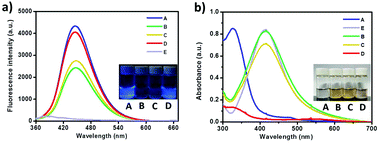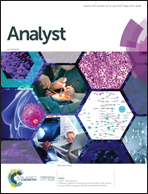A dual-mode fluorometric/colorimetric sensor for Cu2+ detection based on hybridized carbon dots and gold–silver core–shell nanoparticles
Abstract
A fluorometric and colorimetric dual mode sensing platform based on hybridized carbon dots (Cdots) and gold–silver core–shell nanoparticles (Au@Ag NPs) has been established for the sensitive detection of trace Cu2+ ions in aqueous solution. In this system, the fluorescence of Cdots was quenched by Au@Ag NPs due to the surface plasmon-enhanced energy transfer. Due to the fact that Cu2+ could accelerate the etching process of Au@Ag NPs in the presence of thiosulfate, the fluorescence of Cdots was recovered. The limit of detection (LOD) is 4.81 nM for fluorometric measurements and 3.85 nM for colorimetric measurements. The dynamic range from these two modes is 0.005–1 μM. Importantly, Cu2+ in solution can also be directly visualized by this sensor via evident color change from the solution. Therefore, this dual mode nanosensor has potential applications for the efficient detection of Cu2+ ions in aqueous samples with great selectivity and high sensitivity.

- This article is part of the themed collection: Analyst Recent HOT articles


 Please wait while we load your content...
Please wait while we load your content...